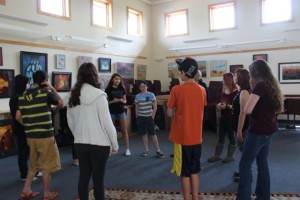Making in School – Resources
|
This activity is from the Systems-Thinking Playbook |
Introduction |
| Participants must throw a ball or object in a particular order until it has been
passed to every person. In this activity, page |
Equipment/Supplies |
| Simple soft objects that can be tossed around among students. Soft balls such as Koosh, Fleece, or Foam, small stuffed animals like beanie babies, juggling balls, tennis balls in socks, just about anything that can be easily caught in a single hand will work. |
Activity/Process |
| Explain to students that they are tasked with this Group Challenge.
Pass the ball around the circle until each participant has gotten it just once, and then return the ball to the leader. Each person must get it just once, and you cannot pass it to the person next to you. You must call out the name of the person who you are tossing the ball or object to. After the first round, time the group from start to finish. Challenge them to repeat the process, and beat their time. You can allow them a few rounds to beat their best time. When you feel the group has begun to feel confident at this task, introduce a second ball or object to toss. You can continue to introduce additional objects as the groups improves their time and skill with one or more balls or object. The systems thinking playbook: Exercises to stretch and build learning and systems thinking capabilities (1996)by Booth Sweeney, L, D Meadows
|
WHAT IS AGILE?
Excellent description of Agile Values and how they are applied.
Also descriptions of how it feels to work in an agile framework.
This comes from the Agile Manifesto of Software Development,
but can easily transfer and describe how we approach this in learning environment.
- Individuals and interactions over processes and tools
- Working software over comprehensive documentation
- Customer collaboration over contract negotiation
- Responding to change over following a plan
Agile Classrooms Website
The Daily Standup
WHAT IS AGILE?
Excellent description of Agile Values and how they are applied.
Also descriptions of how it feels to work in an agile framework.
This comes from the Agile Manifesto of Software Development,
but can easily transfer and describe how we approach this in learning environment.
- Individuals and interactions over processes and tools
- Working software over comprehensive documentation
- Customer collaboration over contract negotiation
- Responding to change over following a plan
Agile Classrooms Website
The Daily Standup

MindSet Works – Brain Research and the Growth Mindset
Edutopia Tools for Developing Focus – with Daniel Goleman
Educational Cognitive Neuroscience Lab
The Social Neuroscience of Education
“The Social Neuroscience of Education shares the most current neurological and sociological intelligence about creating classrooms that offer and reward emotional empowerment,
where brains are “turned on” so that students can connect and enjoy learning. And just as important as turning on students’ brains, Cozolino points out, is supporting educators: Attachment learning provides the same fertile foundation to excite and challenge teachers.”
Rules of Extreme Programming
http://www.edutopia.org/blog/pbl-through-a-makers-lens-patrick-waters
Hybrid Pedagogy – Situating Maker Spaces in Schools
How the Makers Movement is transforming education
Learning By Making – Agency By Design and the rise of Maker Centered Education Harvard Graduate School of Education
Learning by Making by Dale Dougherty, founder of Make Magazine
Sources of Kits and Supplies
